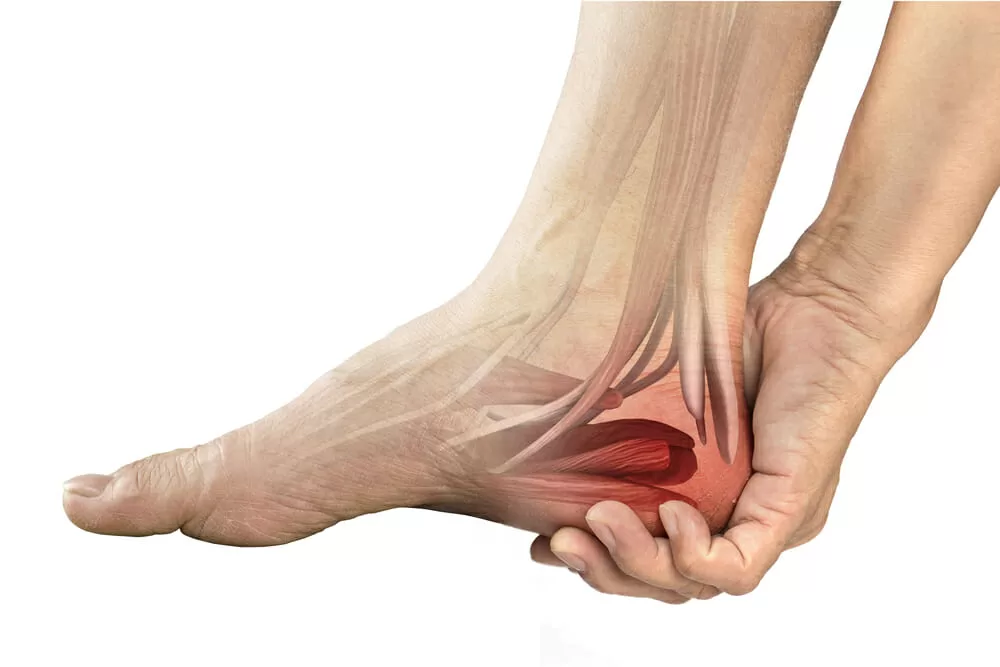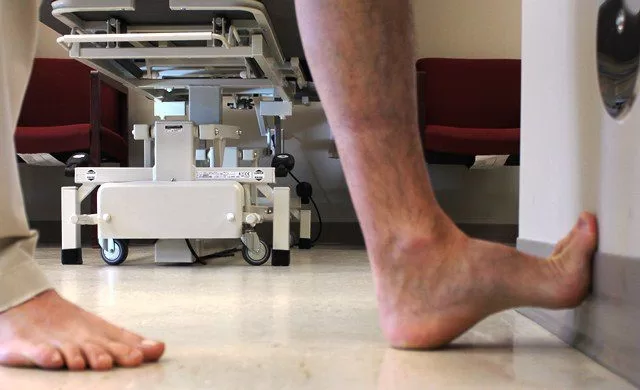Frequently Asked Questions
Plantar fasciitis is a common foot condition that causes pain in the heel, across the sole of the foot and sometimes into the arch area of the foot too.
It is caused by repetitive strain to the plantar fascia, which is a fibrous band of tissue connecting your heel bone to the ball of your foot. It is a very important structure that helps to reinforce the arch of your foot and acts like a ‘bow string’ to stiffen your foot when you walk. Multiple tiny areas of damage occur over and over to the fascia, which heal with scar tissue, this scar tissue is stiffer (less flexible) than the normal tissue.
Variable pain: Pain is usually felt around the heel bone, and on the sole of the foot (the part that touches the ground), but can also spread to the arch of the foot too. People often complain of ‘first step’ pain, when they first get up. You may find this pain settles during the day and with exercise, but is worse again at the end of the day or after a lot of activity.
Morning stiffness: Many people complain of stiffness around the heel bone, particularly when they first get up or after a period of rest. This usually eases after a few minutes of walking, but may last longer.
Tenderness: Often the underside of the heel is tender when pressed. Sometimes this is quite general, but usually there is one particularly tender spot.
Many things affect the load being put through your plantar fascia. Plantar fasciitis is not simply the result of exercising or standing or walking too much. General risks include:
- Age: it is more common between the age of 40 and 60 years
- Gender: it is more common in women than men
- Weight: you have a higher risk if you are overweight
- Diabetes: people with diabetes are more likely to get plantar fasciitis
- Flexibility: reduced ankle movement can increase the risk
- Foot type: it is more common in people with high arched feet
- Footwear: old or poor quality footwear can also increase the risk.
- Occupation: more common in occupations requiring long periods standing/walking
It can usually be confirmed by your doctor or physiotherapist using your medical history and examination. It is not necessary to carry out routine X-rays or scans.
If a scan is required then this will likely be an ultrasound scan. This is a quick, safe, and effective way of seeing the plantar fascia, by rolling a handheld probe over your skin above your plantar fascia. Magnetic Resonance Imaging (MRI) is also sometimes used.
If you have already had an X-ray this may or may not show a heel spur, which is a small piece of bone that can grow on the underside of the heel bone, near the plantar fascia. This can be mistaken as the cause of plantar fasciitis. We know that approximately 3 in every 10 people have a heel spur and very few of them have heel pain. Similarly, many people with plantar fasciitis do not always have a heel spur.
As with many foot and ankle conditions, plantar fasciitis can in most instances be treated by you, at home, without the need to see a health professional. 90% of patients get better on their own within 2 years.
Rest / Modified Activities:
Plantar fasciitis is basically a mechanical overload and the treatments revolve around reducing this overloading. The aim is to initially reduce your activity levels, allow for recovery, and then gradually increasing them as the condition improves.
Try to think about your daily routine, such as going to work or jobs around the house where you are on your feet. Can you think of ways to temporarily reduce the time spent on your feet? Try to adjust your work pattern to break up long periods of standing or being on your feet. Use the intensity and duration of your pain as a guide.
You can help to maintain your fitness using different forms of exercise that do not significantly aggravate your symptoms, such as swimming, cycling, aqua jogging (running in water).
Ice & Massage:
Massaging the heel and foot arch area can help ease the symptoms, though initially it can be tender to do so.
The tissues around the plantar fascia can go into spasm and become tense, however massage can ease this and over time it should become more comfortable. You can use your fingers, someone else can do it, or you can use something such as a rolling pin or a golf or tennis ball to roll over the foot.
Do this for about five minutes at a time, once or twice a day. Because your heel maybe a little tender after this, it is the ideal time to ice the area. You only need to ice it for five to ten minutes maximum to get the desired effect.
Stretching:
A number of research studies have shown stretching to be the most effective treatment for plantar fasciitis.
Stretching should not be painful – you should feel a gentle stretch and then hold this for at least 30 seconds. As you stretch you will gradually start to feel the resistance ease as the tissues in your foot give. Repeat this at least three to five times for each side and, if possible, try to do this more than once a day.
Remember that you will need to be patient with this. Some people feel an immediate benefit, whilst for others it takes a little longer.
Footwear:
Footwear should be supportive, not compress your feet too much, fit-well and have cushioned soles, especially in the heel area. Avoid walking in bare feet or flip flops.
Maintain your shoes in good condition and renew your trainers every 300 to 500 miles. Consider having two pairs of trainers ‘on the go’ at the same time if you are a runner.
Taping:
The use of taping as a short-term therapy may be helpful, particularly after a period of rest, pain killers, stretching and massage has helped to settle your symptoms. Taping can help to offload the plantar fascia when you start doing more activity and as a result put more strain on the healing plantar fascia ligament. Further information on taping can be provided by your physiotherapist.
Foot supports:
There are many different types of orthotics (foot supports) available, and unfortunately they vary significantly in quality and usefulness. Often they can be found at the chemist or at sports shops. Alternatively, there are reputable websites such as www.simplyfeet.co.uk and www.heelfixkit.com that supply insoles to the general public.
Going for a soft arch support with a cushioned heel is a safe place to start.
Night splints:
Night splints work on the same principle as stretching, but are worn for longer periods, applying a constant stretch to the plantar fascia. Ideally they should be worn all night, but this may be impractical. Be aware that they can take some getting used to and need to be worn for some time before any beneficial effects are experienced.
Night splints can be purchased from websites such as www.simplyfeet.co.uk.
Ice:
Applying ice wrapped in a damp tea towel to the affected area can help reduce pain. Apply for a maximum of 20 minutes, 4 times a day, or after exercise. Please take care not to apply ice for too long or directly to the skin, as this can cause ice burns. Do not apply ice/ice packs to an area where you have numbness, decreased sensation or poor circulation.
Painkillers:
A short course of over-the-counter painkillers such as paracetamol or anti-inflammatories (e.g. ibuprofen) may be helpful if your pain is severe. Anti-inflammatories should be taken with food. If you are needing stronger or longer courses of painkillers consult your GP.
Managing your weight:
If you are overweight, see your GP to discuss strategies to help you lose weight. This can make a big difference to your plantar fasciitis and general health.
In the first instance you should give these first line treatments 6 to 12 weeks to have an effect. If you are getting improvement, you should continue these treatments until the symptoms have resolved. If in the future the same symptoms return, then restart these first line treatments.
If initial treatments do not improve your symptoms, your physiotherapist or doctor will discuss other options with you. These may include:
- Podiatry referral for assessment for shoe inserts
- Night splints
- Capsaicin cream
- Dry needling, with or without autologous blood injection (a procedure to try and stimulate healing in the tendon)
- Extracorporeal shockwave therapy (a machine is used to deliver sound waves to the painful area, to stimulate healing)
The latest evidence suggests that steroid injections are not the best treatment option. There is a risk of the plantar fascia rupturing (tearing) following a steroid injection, and it may cause wasting of the fat pad cushion under your heel. This can lead to long term problems. For these reasons, we do not routinely use steroid injections as a treatment option.




